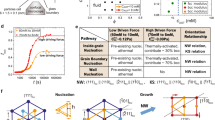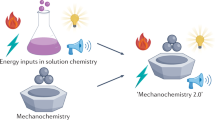Abstract
Usually, mechanochemical reactions between solid phases are either gradual (by deformation-induced mixing), or self-propagating (by exothermic chemical reaction). Here, by means of a systematic kinetic analysis of the Bi–Te system reacting to Bi2Te3, we establish a third possibility: if one or more of the powder reactants has a low melting point and low thermal effusivity, it is possible that local melting can occur from deformation-induced heating. The presence of hot liquid then triggers chemical mixing locally. The molten events are constrained to individual particles, making them distinct from self-propagating reactions, and occur much faster than conventional gradual reactions. We show that the mechanism is applicable to a broad variety of materials systems, many of which have important functional properties. This mechanistic picture offers a new perspective as compared to conventional, gradual mechanochemical synthesis, where thermal effects are generally ignored.
This is a preview of subscription content, access via your institution
Access options
Subscribe to this journal
Receive 12 print issues and online access
$259.00 per year
only $21.58 per issue
Buy this article
- Purchase on Springer Link
- Instant access to full article PDF
Prices may be subject to local taxes which are calculated during checkout






Similar content being viewed by others
References
Hickenboth, C. R. et al. Biasing reaction pathways with mechanical force. Nature 446, 423–427 (2007).
Seidel, C. A. M. & Kühnemuth, R. Mechanochemistry: molecules under pressure. Nat. Nanotech. 9, 164–165 (2014).
Sawyer, W. G., Argibay, N., Burris, D. L. & Krick, B. A. Mechanistic studies in friction and wear of bulk materials. Annu. Rev. Mater. Res. 44, 395–427 (2014).
Pastewka, L., Moser, S., Gumbsch, P. & Moseler, M. Anisotropic mechanical amorphization drives wear in diamond. Nat. Mater. 10, 34–38 (2011).
Suryanarayana, C. Mechanical alloying and milling. Prog. Mater. Sci. 46, 1–184 (2001).
James, S. L. et al. Mechanochemistry: opportunities for new and cleaner synthesis. Chem. Soc. Rev. 41, 413–447 (2012).
Friščić, T. et al. Real-time and in situ monitoring of mechanochemical milling reactions. Nat. Chem. 5, 66–73 (2013).
Katsenis, A. D. et al. In situ X-ray diffraction monitoring of a mechanochemical reaction reveals a unique topology metal-organic framework. Nat. Commun. 6, 6662 (2015).
Baláž, P. & Dutková, E. Fine milling in applied mechanochemistry. Miner. Eng. 22, 681–694 (2009).
McCormick, P. G. & Froes, F. H. The fundamentals of mechanochemical processing. JOM 50, 61–65 (1998).
Baláž, P. et al. Hallmarks of mechanochemistry: from nanoparticles to technology. Chem. Soc. Rev. 42, 7571–7637 (2013).
Valiev, R. Nanostructuring of metals by severe plastic deformation for advanced properties. Nat. Mater. 3, 511–516 (2004).
Xu, J., Herr, U., Klassen, T. & Averback, R. S. Formation of supersaturated solid solutions in the immiscible Ni–Ag system by mechanical alloying. J. Appl. Phys. 79, 3935–3945 (1996).
Gente, C., Oehring, M. & Bormann, R. Formation of thermodynamically unstable solid solutions in the Cu–Co system by mechanical alloying. Phys. Rev. B 48, 13244–13252 (1993).
Han, B. Q., Ye, J., Tang, F., Schoenung, J. & Lavernia, E. J. Processing and behavior of nanostructured metallic alloys and composites by cryomilling. J. Mater. Sci. 42, 1660–1672 (2007).
Martin, G. & Bellon, P. Driven alloys. Solid State Phys. 50, 189–331 (1996).
Lund, A. C. & Schuh, C. A. Driven alloys in the athermal limit. Phys. Rev. Lett. 91, 235505 (2003).
Odunuga, S., Li, Y., Krasnochtchekov, P., Bellon, P. & Averback, R. S. Forced chemical mixing in alloys driven by plastic deformation. Phys. Rev. Lett. 95, 045901 (2005).
Vo, N. Q., Odunuga, S., Bellon, P. & Averback, R. S. Forced chemical mixing in immiscible alloys during severe plastic deformation at elevated temperatures. Acta Mater. 57, 3012–3019 (2009).
Ashkenazy, Y., Vo, N. Q., Schwen, D., Averback, R. S. & Bellon, P. Shear induced chemical mixing in heterogeneous systems. Acta Mater. 60, 984–993 (2012).
Xu, J., He, J. H. & Ma, E. Effect of milling temperature on mechanical alloying in the immiscible Cu–Ta system. Metall. Mater. Trans. A 28, 1569–1580 (1997).
Koch, C. C. The synthesis of non-equilibrium structures by ball-milling. Mater. Sci. Forum 88–90, 243–262 (1992).
Benjamin, J. S. Fundamentals of mechanical alloying. Mater. Sci. Forum 88–90, 1–18 (1992).
Takacs, L. Self-sustaining reactions induced by ball milling: an overview. Int. J. Self-Propag. High-Temp. Synth. 18, 276–282 (2010).
Takacs, L. Self-sustaining reactions induced by ball milling. Prog. Mater. Sci. 47, 355–414 (2002).
Maurice, D. R. & Courtney, T. H. The physics of mechanical alloying: a first report. Metall. Trans. A 21, 289–303 (1990).
Lewandowski, J. J. & Greer, A. L. Temperature rise at shear bands in metallic glasses. Nat. Mater. 5, 15–18 (2006).
Bowden, F. P. & Persson, P. A. Deformation, heating and melting of solids in high-speed friction. Proc. R. Soc. Lond. 260, 433–458 (1961).
Gerasimov, K. B. & Boldyrev, V. V. On mechanism of new phases formation during mechanical alloying of Ag–Cu, Al–Ge and Fe–Sn systems. Mater. Res. Bull. 31, 1297–1305 (1996).
Urakaev, F. K. & Boldyrev, V. V. Mechanism and kinetics of mechanochemical processes in comminuting devices: 1. Theory. Powder Technol. 107, 93–107 (2000).
Delogu, F. A possible alloying mechanism in idealized collisions between Cu and Sn crystals. Chem. Phys. Lett. 521, 125–129 (2012).
Delogu, F. & Cocco, G. Crystallite size refinement in elemental species under mechanical processing conditions. Mater. Sci. Eng. A 422, 198–204 (2006).
Delogu, F., Schiffini, L. & Cocco, G. The invariant laws of the amorphization processes by mechanical alloying. Phil. Mag. A 81, 1917–1937 (2001).
Morgant, G., Feutelais, Y., Legendre, B., Castanet, R. & Coulet, A. Themodynamic behaviour of Bi–Te alloys. Z. Fuer Met. Res. Adv. Tech. 81, 44–48 (1990).
Misra, S. & Bever, M. B. On the solid solutions of bismuth telluride and bismuth selenide. J. Phys. Chem. Solids 25, 1233–1241 (1964).
Humphry-Baker, S. A. & Schuh, C. A. The nanocrystalline thermoelectric compound Bi2Te3 forms by a particle-wise explosive reaction during mechanical alloying. Scr. Mater. 65, 516–519 (2011).
Su, X. et al. Self-propagating high-temperature synthesis for compound thermoelectrics and new criterion for combustion processing. Nat. Commun. 5, 4908 (2014).
Takacs, L. Ball milling-induced combustion in powder mixtures containing titanium, zirconium, or hafnium. J. Solid State Chem. 125, 75–84 (1996).
Delogu, F. & Takacs, L. Mechanochemistry of Ti–C powder mixtures. Acta Mater. 80, 435–444 (2014).
Schwarz, R. B. & Koch, C. C. Formation of amorphous alloys by the mechanical alloying of crystalline powders of pure metals and powders of intermetallics. Appl. Phys. Lett. 49, 146–148 (1986).
Shackelford, J. F. & Alexander, W. CRC Materials Science and Engineering Handbook (CRC Press, 2001).
Abdellaoui, M. & Gaffet, E. The physics of mechanical alloying in a modified horizontal rod mill: mathematical treatment. Acta Mater. 44, 725–734 (1996).
Monagheddu, M., Doppiu, S. & Cocco, G. MSR reduction of hexachlorobenzene. J. Mater. Synth. Process. 8, 295–300 (2000).
ASM Handbook Volume 2: Properties and Selection: Nonferrous Alloys and Special-Purpose Materials (ASM International); http://www.asminternational.org/materials-resources/results/-/journal_content/56/10192/06182G/PUBLICATION
Tschakarov, C. G., Gospodinov, G. G. & Bontschev, Z. Über den Mechanismus der mechanochemischen Synthese anorganischer Verbindungen. J. Solid State Chem. 41, 244–252 (1982).
Ramasamy, K., Malik, M. A., Revaprasadu, N. & O’Brien, P. Routes to nanostructured inorganic materials with potential for solar energy applications. Chem. Mater. 25, 3551–3569 (2013).
Musu, E., Mura, G., Ligios, G. & Delogu, F. Formation of metastable solid solutions by mechanical alloying of immiscible Ag and Bi. J. Alloys Compd. 576, 80–85 (2013).
Delogu, F. & Cocco, G. Kinetics of structural evolution in immiscible Ag–Cu and Co–Cu systems under mechanical processing conditions. Mater. Sci. Eng. A 402, 208–214 (2005).
Delogu, F., Mulas, G., Schiffini, L. & Cocco, G. Mechanical work and conversion degree in mechanically induced processes. Mater. Sci. Eng. A 382, 280–287 (2004).
Acknowledgements
F.D. and S.G. are grateful to Prof. Stefano Enzo, Dipartimento di Chimica e Farmacia, Università degli Studi di Sassari, for his help in the quantitative analysis of XRD patterns. This material is partially based on work supported as part of the ‘Solid State Solar-Thermal Energy Conversion Center (S3TEC)’, an Energy Frontier Research Center funded by the US Department of Energy, Office of Science, Office of Basic Energy Sciences under Award Number DE-SC0001299 (S.A.H.-B. and C.A.S.). The material is also partially supported by the Universities of Cagliari and Sassari (F.D. and S.G., respectively).
Author information
Authors and Affiliations
Contributions
F.D., S.G. and S.A.H.-B. designed and performed experiments; F.D., C.A.S. and S.A.H.-B. analysed the data and co-wrote the manuscript.
Corresponding author
Ethics declarations
Competing interests
The authors declare no competing financial interests.
Supplementary information
Supplementary Information
Supplementary Information (PDF 6456 kb)
Rights and permissions
About this article
Cite this article
Humphry-Baker, S., Garroni, S., Delogu, F. et al. Melt-driven mechanochemical phase transformations in moderately exothermic powder mixtures. Nature Mater 15, 1280–1286 (2016). https://doi.org/10.1038/nmat4732
Received:
Accepted:
Published:
Issue Date:
DOI: https://doi.org/10.1038/nmat4732
This article is cited by
-
Chemical effects induced by the mechanical processing of granite powder
Scientific Reports (2022)
-
Effect of ball collision direction on a wet mechanochemical reaction
Scientific Reports (2021)
-
Mechanochemical conversion kinetics of red to black phosphorus and scaling parameters for high volume synthesis
npj 2D Materials and Applications (2020)
-
Melt-driven erosion in microparticle impact
Nature Communications (2018)
-
Nanocrystalline non-equilibrium alloys of molybdenum with sodium
Journal of Materials Science (2018)



